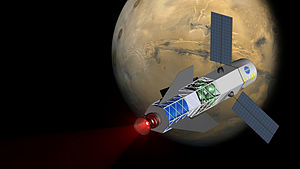Nuclear pulse propulsion

Concept graphic of a Fusion Driven Rocket powered Spacecraft arriving at Mars
|
|
| Designer | MSNW LLC |
|---|---|
| Application | Interplanetary |
| Status | Theoretical |
| Performance | |
| Specific impulse | 1,606 s to 5,722 s (depending on fusion gain) |
| Burn time | 1 day to 90 days (10 days optimal with Gain of 40) |
| References | |
| References | |
| Notes |
Fuel: Deuterium-Tritium Cryogenic Pellet Propellent: Lithium or Aluminum Power Requirements: 100 kW to 1,000 kW |
Nuclear pulse propulsion or external pulsed plasma propulsion, is a hypothetical method of spacecraft propulsion that uses nuclear explosions for thrust. It was first developed as Project Orion by DARPA, after a suggestion by Stanislaw Ulam in 1947. Newer designs using inertial confinement fusion have been the baseline for most post-Orion designs, including Project Daedalus and Project Longshot.
Project Orion was the first serious attempt to design a nuclear pulse rocket. The design effort was carried out at General Atomics in the late 1950s and early 1960s. The idea of Orion was to react small directional nuclear explosives utilizing a variant of the Teller-Ulam two-stage bomb design against a large steel pusher plate attached to the spacecraft with shock absorbers. Efficient directional explosives maximized the momentum transfer, leading to specific impulses in the range of 6,000 seconds, or about thirteen times that of the Space Shuttle Main Engine. With refinements a theoretical maximum of 100,000 seconds (1 MN·s/kg) might be possible. Thrusts were in the millions of tons, allowing spacecraft larger than 8 × 106 tons to be built with 1958 materials.
The reference design was to be constructed of steel using submarine-style construction with a crew of more than 200 and a vehicle takeoff weight of several thousand tons. This low-tech single-stage reference design would reach Mars and back in four weeks from the Earth's surface (compared to 12 months for NASA's current chemically powered reference mission). The same craft could visit Saturn's moons in a seven-month mission (compared to chemically powered missions of about nine years).
...
Wikipedia
